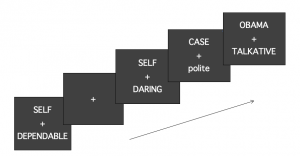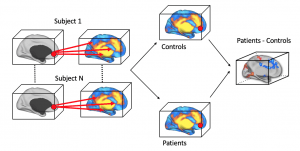Maladaptive self-focused attention is a processing style characterized by a tendency to focus on one’s internal thoughts, feelings, beliefs, and physical states, at the expense of processing information from the external environment. Cognitive theories of anxiety disorders propose that maladaptive self-focused attention is an important maintaining factor of psychopathology, which may interfere with new learning that takes place during exposure therapy. Despite this, few experimental studies have examined its neurocognitive and behavioral effects and the brain correlates of this attentional process remain unknown. The goal of the current project is to identify the brain correlates of self-focused attention, which we propose maps onto a set of regions within the default mode network, an intrinsic brain network hypothesized to mediate internal mentation.
To measure the brain correlates of self-focused attention, we use task-based and resting state fMRI:
Self-Other fMRI Task: Participants are asked to respond whether trait adjectives are descriptive of themselves (SELF condition), former President Barack Obama (OTHER condition), or whether the adjectives are printed in uppercase letters (CASE condition). This is a widely-used task that probes self-referential processing in core default mode network regions. Task adapted based on Kelley et al., 2011, Journal of Cognitive Neuroscience.
Resting state functional connectivity MRI: Participants are asked to rest with their eyes open while in the scanner. We use seed-based connectivity analyses to examine connectivity between self-related brain regions within the default mode network. Image adapted from Anticevic et al., 2014, Cerebral Cortex.

